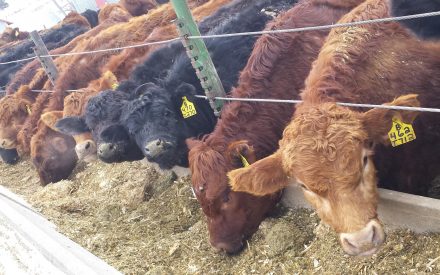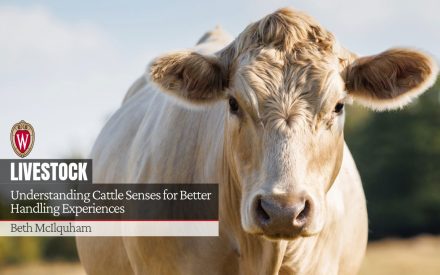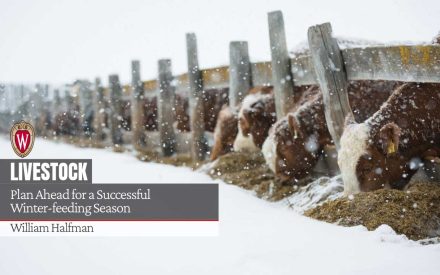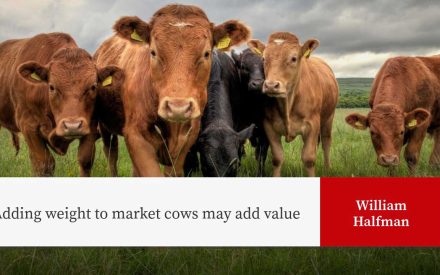This article was originally published in Wisconsin Agriculturist Magazine
Preconditioning beef calves prepares them for a successful weaning and life after they leave home. Calves not preconditioned are frequently discounted at market as they are more likely to suffer health problems and perform less efficiently and ultimately have lower valued carcasses 1. The goal of your farm’s preconditioning program is to build a health and nutrition plan that meets the buyer’s expectations and includes tasks your farm can achieve.
Buyer’s preferences and expectations include calves that are castrated (knife cut preferred), dehorned, eating well at a bunk, and drinking water on their own. Health program status is also important so be sure to share your calves’ vaccination and deworming status, including what products were administered. Extension’s Preconditioning Tools can help with record-keeping.
Some farms don’t precondition calves because they do not have facilities to handle cattle or feed calves, nor time to accomplish the tasks involved. These are poor excuses! Learn about cattle handling and invest in facilities that allow you to handle cattle in a safe and timely manner. National Beef Quality Assurance has videos and print resources are available.
I worked with my veterinary colleague to design a Preconditioning Schedule planning tool to use during conversations with your veterinarian and nutritionist. The goal for using it is to develop the post-calving preconditioning program that works on your farm and meets the expectations of your calf buyer. Most tasks can be accomplished during three handling events with newborn, pre-weaned and weaned calves. Immediately schedule the corresponding preconditioning dates/tasks once your calf crop is born. Pre-planning allows you to have inventory, equipment, labor, and your facility ready to process and feed calves.
Neonatal processing includes identifying the calf, disinfecting its navel, and making sure it nurses or is fed colostrum (or colostrum supplement or replacer). Follow your plan to administer vaccinations for newborn and pre-weaned calves. Castrate and dehorn calves before their third month of age. Vaccine boosters are often given just prior, at or just after weaning. Use equipment or build a facility that will allow you to process calves, often in conjunction with the cow’s lifecycle events (vaccination, breeding, pregnancy checking, etc.).
Forty-five-day weaning periods are commonly talked about and lately, some buyers prefer 60-day weaned calves. This time period starts the day calves are weaned (separated from the momma cow) and fed on the farm for 45 – 60 days prior to their sale date. Using birth records, calculate an average date of birth for your calf crop. The weaning date is then pre-determined from that birthday or from the expected sale date. The anticipated sale date is pre-determined to reflect business goals or from the calf crop’s birthdate. These dates set your calendar of processing tasks.
For example, Farm A has identified the market that will purchase preconditioned calves on March 1. This market’s buyers want 700 lbs. calves that are vaccinated and fed for a minimum of 45 days post weaning before being marketed. If the calf-crop’s average birth date is June 1, when does weaning need to occur? The answer is January 14 based upon calf readiness for the sale date. Preconditioning processing tasks can be scheduled June through January with post-weaning nutrition from January to March enabling calves to reach their desired market weight.
Information from your Preconditioning Schedule may be transferred to the Preconditioning Record Form. Sharing preconditioning records with potential buyers builds trust in your reputation.
Citations
- 2019 Cattlemen’s Beef Board and National Cattlemen’s Beef Association, Beef Quality Assurance Manual, Chapters 7 Nutrition and 6 Recordkeeping.
Reviewed by: Ryan Sterry and Bill Halfman, UW-Madison Division of Extension Agriculture Agents in St. Croix and Monroe Counties.


 Preconditioning Calves: Establishing Your Reputation
Preconditioning Calves: Establishing Your Reputation Understanding Cattle Senses for Better Handling Experiences
Understanding Cattle Senses for Better Handling Experiences Plan Ahead for a Successful Winter-feeding Season
Plan Ahead for a Successful Winter-feeding Season Adding weight to market cows may add value
Adding weight to market cows may add value


